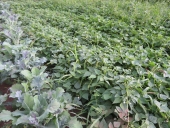An update: with DS help a little more was cut, and then we went to a weed-whacker and a rake. This did not work so well.
Many of the heavy stems were not cut entirely through, and it was difficult to rake what WAS cut through. I am fairly sure the shorter plants just had the heads cut off and were lost in the tallish grass. It might have worked better if the wheat was whacked off at ground level instead of in the middle where the wheat
rose above the lawn grass. So, cutting the wheat with nippers gave me a better yield, though the poor yield with a weed whacker might have been partly due to a teenager using it instead of myself. Hey, I wanted it whacked and it was DEFINATELY whacked down! I did not scold, he HAD followed my directions very well and it was very hot out! We are both novices in this. So, the most productive way I have found to harvest it is to grab a handful of stems, cut with a serrated knife or nippers, and lay it down in a neat pile and then move on to the next handful.
But, it was cut. It is very hot, and most of the wheat is already brown. The remainder of the yard will be mowed this morning.
Shocking the wheat is simply putting it into bundles and tying it. Shocked wheat can be set up so that it leans on other shocks, and this keeps the grain off of the damp ground so it dries where the air can get to it. Traditionally, the shocks can be tied into bundles with 2-3 stalks of wheat but string is also used. I have done it both ways: if you use stalks of wheat to tie the bundles then the bundles must be smaller. I prefer this method as I do not have to carry string about!
So, the wheat has been cut and shocked and a large armful is on the back deck, against the wall where it is more or less protected from rain.
I reviewed my older posts: I had not remembered planting milo and birdseed! And, I see no sign of it now though the wheat has done well
enough to encourage me greatly. This fall I will plant grain where the two sheds block the easy view. And, instead of planting it in rows I will plant a solid patch for a greater yield.






 2
2




 1
1




 1
1




 1
1




 1
1




















 1
1









